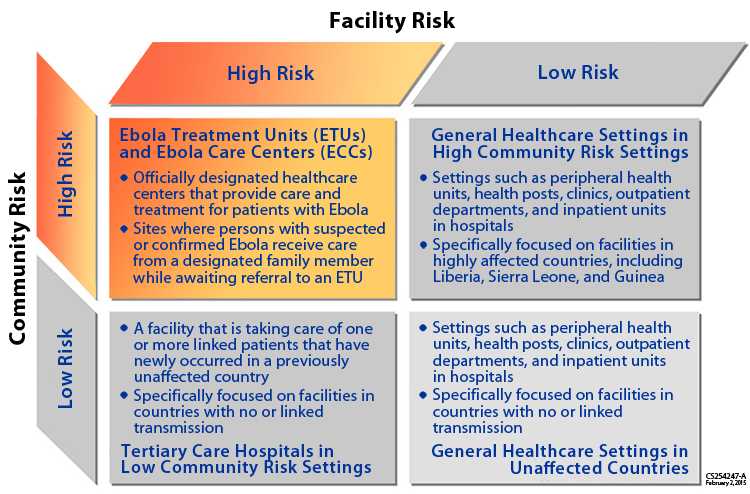Determining Risk of Ebola Transmission in Healthcare and Community Settings
Page Summary
Who this is for: Healthcare workers engaged in public health, policy, planning, and risk analysis in West Africa.
What this is for: To provide assessment criteria to determine and manage the risk of Ebola transmission in a healthcare facility or community with people under investigation (PUIs) for Ebola virus disease (EVD) or with confirmed EVD.
How to use: Apply the criteria provided to analyze and assess the risk level in a healthcare facility or community.
Key Points
- Since the discovery of the Ebola virus, there have been Ebola infections among healthcare workers in almost every outbreak. Protecting healthcare workers from Ebola virus disease and improving infection control are critical elements to provide reliable health care and stop the epidemic.
- Infection control is a key strategy in stopping the Ebola epidemic and in preventing future outbreaks.
- Infections have led to health facility closures, distrust in the healthcare system, direct and indirect loss of the healthcare workforce, and weakened infrastructure needed to treat more common ailments in the region, like malaria and cholera.
- Recommended infection control measures depend on the risk of transmission in the facility and the community.
Cases of Ebola infections among healthcare workers can have devastating effects on healthcare systems and the communities they serve. These cases have led to health facility closures, distrust in the healthcare system, and direct and indirect loss of the healthcare workforce. These effects weaken efforts to control the epidemic and can lead to a collapse of the basic healthcare infrastructure needed to treat more common ailments in the region, like malaria and cholera.
Infection control is a key strategy in stopping the Ebola epidemic and in preventing future outbreaks of disease. Many measures may be used for infection control, both in the community and in healthcare settings. How these infection control measures are put into action depends on the level of risk in the facility and the community.
Two factors help determine the level of risk in community and healthcare settings:
- The local and regional Ebola transmission risk in the community.
- The risk from people under investigation PUIs or and patients with confirmed EVD under care in a given facility.
Community Risk
The level of transmission risk in a community is determined by whether there is epidemiologically linked or unlinked community transmission. In linked community transmission, public health authorities are able to link each new case to one or more previously reported cases. In unlinked community transmission, cases are sometimes not able to be traced directly from contact with a person who had EVD previously.
Community: Low Risk
When no cases of EVD have been identified in a community, or when all identified cases can be linked to known cases, a community setting is considered low risk. In low risk community settings, sick patients are evaluated for EVD if exposure to known cases has occurred or if they have traveled to a region where unlinked transmission is occurring. They are evaluated based on known exposures, and clinical signs and symptoms. The goal in low risk settings is to prepare healthcare facilities to handle EVD cases safely if a case is identified.
Community: High Risk
High risk community settings are areas with multiple cases of EVD that cannot be linked to other cases, or are near areas that have unlinked transmission. Patients may be evaluated on the basis of symptoms and laboratory findings alone, because exposure history is not known in unlinked transmission settings. Strict visitor and public access policies must be enforced in these settings. Healthcare workers should use enhanced precautions for safety, such as minimizing patient contact by distancing, and using extended personal protective equipment (PPE) during the care of all patients. Regular monitoring of healthcare workers for symptoms may be required.
Healthcare Facility Risk
The level of risk in any given healthcare facility is determined by whether PUIs or patients with confirmed EVD are receiving care at the facility.
Healthcare Facilities: Low Risk
Facilities with no (PUIs) or patients with confirmed cases of EVD are considered low risk. If a low risk healthcare facility is located in a low risk community, regular monitoring of symptoms in healthcare workers is probably not necessary. Extended PPE for either patient care or environmental cleaning probably should not be required.
Healthcare Facilities: High Risk
Facilities with one or more PUIs or patients with confirmed Ebola, such as an Ebola treatment unit, Ebola care center, community care center, or holding center, are considered high risk. Risk for Ebola transmission to patients or staff is very high, and strict adherence to all infection control measures must be enforced. This includes
- Separation and cohorting of PUIs or patients with confirmed EVD, often through use of physical barriers.
- Separation and cohorting of staff caring for patients with EVD and patients without EVD.
- Strict policies for visitor and public access.
- Screening for symptoms among healthcare workers.
- Appropriate use of extended PPE for care of patients with EVD and environmental cleaning.
- Strict environmental cleaning and disinfection.

- Page last reviewed: February 6, 2015
- Page last updated: December 19, 2014
- Content source:


 ShareCompartir
ShareCompartir